This guide initially displays common arthropods (insects, arachnids, centipedes/millipedes and crustaceans) of all shapes. Use the selectors below to include rare species, select by shape, or search by name.
Arthropods include several different classes: hexapods, arachnids, myriapods and crustaceans. An arthropod is an invertebrate animal with bilateral symmetry, an external skeleton, a segmented body, and jointed appendages arranged in pairs. In order to grow, arthropods have to molt, shedding their whole exoskeleton all at once.
Insects, which comprise the vast majority of hexopods, all have three basic body parts. The head has compound eyes, mouthparts, and antennae that are used as sensory organs. The thorax or mid-section typically has two pairs of wings, if the insect can fly, and three pairs of legs for a total of six. The abdomen contains the insect’s digestive system, reproductive organs and sting organs, if present.
While spiders make up the largest group of arachnids, others in the class include scorpions, harvestmen, ticks, mites, pseudoscorpions and solifuges. Arachnids have eight legs plus two additional pairs of appendages: chelicerae used for feeding and defense and pedipalps which function as a sensory organ or in reproduction. Arachnids do not have antennae or wings and have two main body parts with the head and thorax fused into one. In addition, they have two different types of eyes for a total of eight.
Centipedes and millipedes make up most of the myriapod species. They are best known for their long, segmented bodies with multiple legs, though far fewer than their names imply. In addition, they have a single pair of antennae, simple eyes, and mouthparts on the underside of their bodies.
Most crustaceans are free-living aquatic animals but a few are terrestrial such as the woodlice. Their bodies are composed of segments that are grouped into three regions: head, thorax and abdomen. Each body segment may have one or more pairs of appendages which serve as antennae, mandibles, maxillae, legs and tail.
Over 80% of all living animal species are arthropods. They occupy all kinds of roles: predators, prey, parasites, hosts, herbivores and decomposers and live in all different types of habitats. Many are particularly adapted to life in a dry environments like that of Southwest. This guide focuses on many of the common arthropods in the greater Los Alamos area. However, please note that insects in the Lepidoptera order are discussed separately in the Butterfly and Moth Guide.
Insect, Spider and Kin References
A Checklist of Plant and Animal Species at Los Alamos National Laboratory and Surrounding Areas
A Guide to Arthropods Bandelier National Monument, National Park Service [PDF]
American Arachnological Society
Arnett, RH, Jr. 2000 American Insects: A Handbook of the Insects of America North of Mexico CRC Press
BugGuide.Net
Encyclopedia of Life
Field Guide to Insects and Diseases of Arizona and New Mexico Forests, US Forest Service [PDF]
Grasswitz, T.R. and Dressen, D.R. Pocket Guide to the Native Bees of New Mexico [PDF]
Grasswitz, T.R. and Dressen, D.R. Pocket Guide to the Beneficial Insects of New Mexico [PDF]
A Manual of Grasshoppers of New Mexico
iNaturalist
Insect Identification, New Mexico
Mackay, W. and Mackay, E., 2001 The Ants of New Mexico (Hymenoptera: Formicidae) [PDF]
Museum of Southwestern Biology
New Mexico Spiders
Odonata Central
One Hundred Common Insects of New Mexico, NM State University [PDF]
Sanborn, A.F. and Phillips, P.K., 2013 Biogeography of the Cicadas (Hemiptera: Cicadidae) of North America, North of Mexico [PDF]
Symbiota Collections of Arthropods Network
Sutherland, C.A. Rove Beetles [PDF]
Symbiota Collections of Arthropods Network
Ticks and Tick Borne Diseases
Wildlife Notes – Centipedes and Millipedes [PDF]
Subject Area Experts (all guides)
Steve Cary (butterflies)
Beth Cortright (insects)
Terry Foxx (invasive plants)
Leslie Hansen (mammals)
Richard Hansen (fish, mammals)
Dorothy Hoard (butterflies, trees)
Chick Keller (flowers, herbarium)
Shari Kelley (geology)
Kirt Kempter (geology)
Garth Tietjen (reptiles)
David Yeamans (birds)
Web Development and Content Management
Pat Bacha
Jennifer Macke
Graham Mark
Akkana Peck
Contact
Please contact us for local nature questions and sightings. We welcome comments, corrections, and additions to our guides.
For more information about local nature, please visit our Nature Blog or subscribe to PEEC This Week.
Make Selection
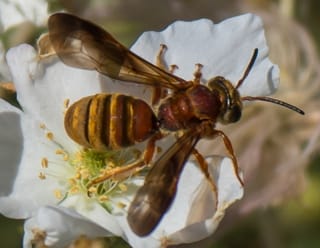 Photo: by Marion L. Stelts 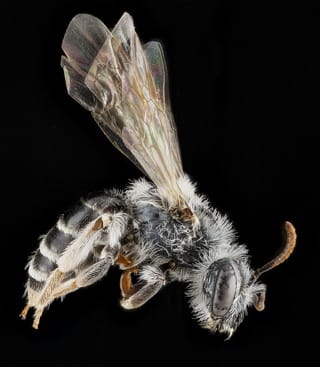 Photo: USGS Bee Inventory and Monitoring Lab |  Mining Bee, Miner Bee, Andrenid Bee(Andrenidae subfamily, Andrenidae family)Order: Hymenoptera (Ants, Bees and Wasps) Size: 0.3 - 0.7 in (8 - 17 mm) Distinguishing Features: moderate-sized bee with scopae or specialized pollen-carrying hairs on their legs; patches of hair between their eyes and at the base of their antennae Status: native; common Habitat: plants in the Rose family in spring and wildflowers later in the year Adult Mining Bees are solitary and emerge from hibernation in spring. After mating, a female will dig a nest with several cells. She lays a single egg into a cell and then provisions it with pollen and nectar before sealing it up and moving on to the next cell. She usually lays about five eggs. Adults are active for only about six to eight weeks. The new generation of adults that emerge will hibernate during winter only to come out the next spring. Little mounds of earth in lawns and soil can be evidence of Mining Bee nests. Mining Bees rarely, if ever, sting and are good pollinators. Info Photos |
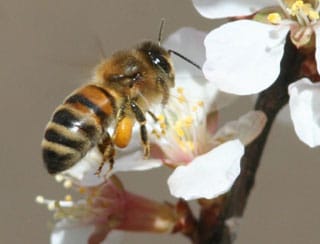 Photo: Selvi Viswanathan |  Honey Bee(Apis mellifera, Apidae family)Order: Hymenoptera (Ants, Bees and Wasps) Size: 0.4 - 0.8 in (10 - 19 mm) Distinguishing Features: overall mostly reddish-brown and black with orange-yellow rings on abdomen; pollen basket on hind legs Status: introduced; common Habitat: workers in areas with high density of flowers; hives in hollow trees or man-made hives maintained by beekeepers The Honey Bee was brought to North America in the 1600s to pollinate crops and produce honey. A colony as large as 60,000 workers will maintain a single queen for up to 2 or 3 years. Honey Bees can sting but are not aggressive; if stung, the stinger should be removed immediately. Due to Colony Collapse Disorder current numbers of bees are abruptly falling leading to concerns about their overall status. Info Photos |
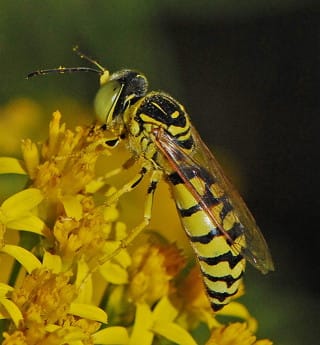 Photo: Jerry Oldenettel |  Sand Wasp(Bembix spp., Crabronidae family)Order: Hymenoptera (Ants, Bees and Wasps) Size: 0.7 - 0.9 in (18 - 23 mm) Distinguishing Features: wasps with a black abdomen and white or yellow curved bands that sometimes meet in the midline; may have greenish eyes Status: native; uncommon Habitat: sandy areas or areas with sparse vegetation and loose soil Females dig nests that typically consist of a short, simple burrow with a single chamber for their eggs. They then stock the nest with captured, paralyzed insects. Adults will continue to provision the nest with food throughout the time that the larvae are developing. Sand wasps can sting but the sting is not as painful as other wasps. Info Photos |
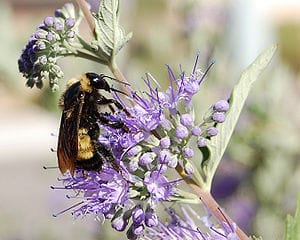 Photo: Skoch3 |  American Bumble Bee(Bombus pensylvanicus, Apidae family)Order: Hymenoptera (Ants, Bees and Wasps) Size: 0.8 - 1 in (19 - 25 mm) Distinguishing Features: yellow thorax and central abdomen with other parts of body being black Status: native; common Habitat: areas with a high density and diversity of flowers The American Bumble Bee can be found throughout North America. In general these bees are not aggressive and will usually only sting when their nests are disturbed. They are generalists and can be seen gathering pollen from a wide variety of flowers. The larger-sized bees seen in the spring are queens that have emerged after overwintering. Info Photos |
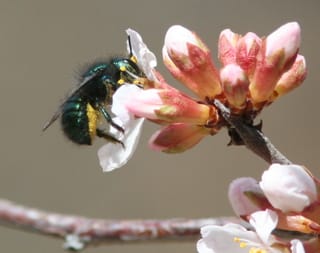 Photo: Selvi Viswanathan 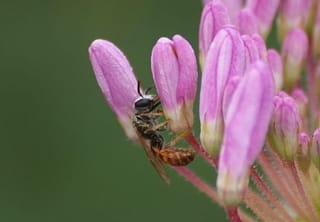 Photo: lostinfog |  Sweat Bee, Halicid Bee(Halictidae family)Order: Hymenoptera (Ants, Bees and Wasps) Size: 0.1 - 0.4 in (3 - 10 mm) Distinguishing Features: generally black or metallic in color; some are brilliant green or brassy yellow Status: native; common Habitat: wide variety of flowers; nests are in the ground or in wood Sweat Bee is the common name for a family of bees that are attracted to salts in human perspiration. There over 200 species of Sweat Bees in the US and it is very difficult to distinguish the different species. Some Sweat Bees are so small that a entire swarm may be missed. Females can sting. Care should be taken to immediately remove the stinger if stung. Info Photos |
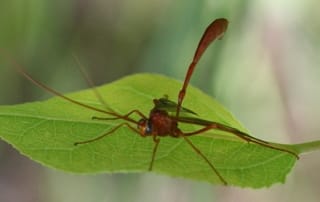 Photo: Selvi Viswanathan 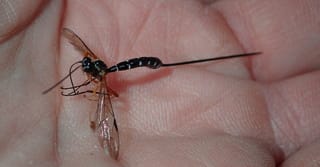 Photo: yetikat |  Ichneumon Wasp(Ichneumonidae family)Order: Hymenoptera (Ants, Bees and Wasps) Size: 0.2 - 5 in (5 - 127 mm) Distinguishing Features: vary greatly in size and color. Have antennae that are longer with more segments than other wasps; long, thin abdomens; females of many species have extremely long ovipositors Status: native; common Habitat: amongst low foliage or grasses Family Ichneumonidae is the largest family of insects, with over 3,000 North American species. They are common insects and occur almost everywhere wandering over the surface of trees and grasses. Ichneumons parasitize a wide range of hosts, mostly other insects. Many ichneumons are internal parasites: the adult female injects her eggs into the body of the host; the larval parasite hatches and develops inside the host; the host typically survives until the parasite pupates. When the female wasp injects her eggs, she also injects certain viruses (polydnavirus) that disrupt the hosts’s immune system. (Yes, insects do have immune systems.) The viruses, which exist only in association with the wasps, enable the wasp to defeat its host. These wasps do not sting. Info Photos |
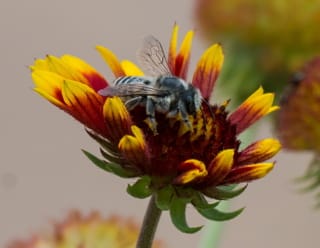 Photo: Marion L. Stelts |  Leaf-cutter Bee, Leafcutting Bee, Mason Bee(Megachilidae family)Order: Hymenoptera (Ants, Bees and Wasps) Size: 0.2 - 0.6 in (5 - 15 mm) Distinguishing Features: medium-sized, stout-bodied, black bees; have hairs on the underside of the abdomen used for carrying pollen and giving it a golden color Status: native; common Habitat: nest in soil, a hole in wood or a hollow plant stem Leaf-cutter Bees are important native pollinators of wildflowers, fruits, vegetables and other crops. Some are even used as commercial pollinators in place of Honey Bees. As their name implies, the bees cut circular pieces of leaves from plants that they use to construct many chambered nests in a protected site. Each chamber contains pollen and a single egg. Most Leaf-cutter Bees overwinter in their nests as newly formed adults. The adults are solitary and will only sting if handled. Info Photos |
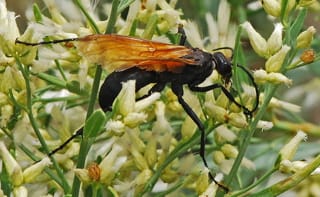 Photo: Jerry Oldennettel |  Tarantula Hawk(Pepsis spp., Pompilidae family)Order: Hymenoptera (Ants, Bees and Wasps) Size: 1.7 - 2 in (43 - 51 mm) Distinguishing Features: large wasps with metallic blue bodies, red or orange wings and long legs ending in claws Status: native; common Habitat: variety of desert habitats often near flowers or on the ground While the adults eat nectar and sometimes rotting fruit, the species is parasitic, i.e., the female paralyzes spiders by stinging them and then laying eggs in the spider's body. The preferred spider is the tarantula, giving the wasp its common name. The Tarantula Hawk's sting is considered to be one of the most painful in the world. Therefore, there are few animals that will eat a Tarantula Hawk, the roadrunner being one of them. The wasp was made the New Mexico state insect in 1989. Info Photos |
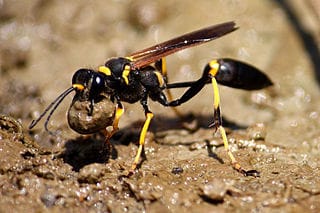 Photo: Hlug1 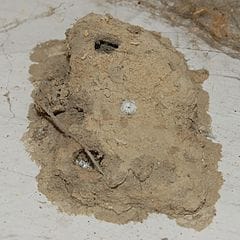 Photo: Eugene Zelenko |  Black and Yellow Mud Dauber(Sceliphron caementarium, Sphecidae family)Order: Hymenoptera (Ants, Bees and Wasps) Size: 1 - 1.1 in (25 - 29 mm) Distinguishing Features: body mostly black with yellow markings on thorax, pedicel (cylindrical segment between thorax and abdomen) and abdominal first segment; legs mostly yellow with wings brown to black Status: native; uncommon Habitat: nests in sheltered areas, under rocks, overhanging cliffs or under eaves of roofs Adults can be seen feeding at flowers. Females create a nest by shaping mud balls into joined tubular cells (bottom photo). Each cell contains numerous paralyzed spiders and one egg. Eventually the hatching larva eats the spiders, grows, spins a cocoon, overwinters as a pupa and ultimately emerges from the nest in the spring as an adult. Stings are painful but the dauber is usually non-aggressive except when defending a nest. Info Photos |
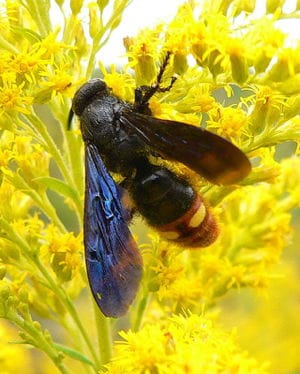 Photo: Greg Hume |  Blue-winged Wasp, Digger Wasp(Scolia dubia, Scoliidae family)Order: Hymenoptera (Ants, Bees and Wasps) Size: 0.8 - 1 in (20 - 25 mm) Distinguishing Features: primarily black and hairy; outer two-thirds of the abdomen is rusty-red with two light-colored dots Status: native; common Habitat: areas with abundant flowers Adults primarily feed on nectar but can take juices from beetle prey. Females will dig in the ground in search of beetle larvae. When found, the female stings the beetle larva to paralyze it, and then burrows further creating a defined cell before laying one egg on the beetle larva's back. The wasp larva feeds on the host, eventually spinning a cocoon within the body of the beetle larva and overwintering as a pupa. Info Photos |
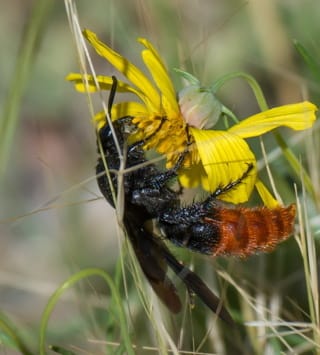 Photo: Marion L. Stelts |  Scoliid Wasp, Flower Wasp(Scoliidae family)Order: Hymenoptera (Ants, Bees and Wasps) Size: 0.8 - 1 in (20 - 25 mm) Distinguishing Features: large, hairy, stout wasps with black antennae and a shiny black head, thorax and fore abdomen; hind abdomen usually colorful, often with patterned spots or bands Status: native; common Habitat: found searching for hosts in fields, meadows and lawns Female Scoliid Wasps dig into the ground to create chambers for their young and to search for ground-dwelling scarab larvae (Scarabaeidae family) to act as hosts. They paralyze the beetle larva by stinging it, move it to one of cells and then lay a single egg on the grub. Thus, since many of the beetles that Scoliid Wasps parasitize are important pests, they are considered to be important biocontrol agents. In addition, adults drink nectar and are minor pollinators for some plants including many wildflowers. Info Photos |
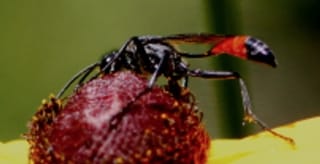 Photo: Selvi Viswanathan  Photo: Emily Hjalmarson |  Thread-waisted Wasps(Sphecidae family)Order: Hymenoptera (Ants, Bees and Wasps) Size: 1 - 1.3 in (25 - 32 mm) Distinguishing Features: long, narrow abdomen giving the impression of a thin waist; body which is hairless can be all black or have some red, yellow or white on it Status: native; uncommon Habitat: most nest in the ground in areas with sparse vegetation; others create nests of mud The Thread-waisted wasps are a diverse group of wasps and includes the sand wasps and mud daubbers. All are predatory with parasitic young. Prey species range from spiders to various insects and even larvae of butterflies. Most Thread-waisted Wasps gather paralyzed prey in some sort of nest in order to provision their young prior to laying eggs. Info Photos |
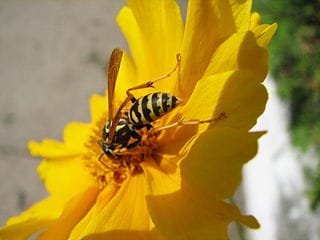 Photo: Audrey |  Yellowjacket(Vespula spp., Vespidae family)Order: Hymenoptera (Ants, Bees and Wasps) Size: 0.4 - 0.5 in (10 - 13 mm) Distinguishing Features: short-waisted and generally black and yellow, though some can be black and white. Yet others may have some red on the abdomen; eyes are encircled in yellow; unlike bees which they are often mistaken for, they are not hairy and do not carry pollen Status: native; common Habitat: nests in protected areas like tree stumps, inside man-mad structures and abandoned rodent burrows Yellowjacket is the common name for a group of predatory wasps with a characteristic, side-to-side flight movement when about to land. They live in colonies with workers (infertile females), queens and male drones. Only the fertilized queen overwinters. Nests are made from wood fiber chewed into a paper-like pulp and can contain thousands of workers. Yellowjackets are important predators of pest insects which they feed to the young larvae. The adults primarily drink fruit juices, nectar, tree sap and a sugary substance that the larvae secrete. Info Photos |
